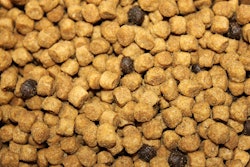
Pet food manufacturers looking to innovate with alternative protein sources now have fresh consumer insights to guide their product development and marketing strategies. At the Petfood Forum 2025, Nicole Hill, executive director of strategy at Nextin Research by MarketPlace, presented new data on pet owner attitudes toward novel proteins ranging from insects to cultivated meat.
"When we think about who would be willing to sample a novel protein-based pet food with their pets, we looked at a wide range of novel proteins, everything from bison and rabbit to ostrich and alligator to cultivated meat and insect proteins," Hill explained during her presentation, which drew from surveys conducted in March and April 2025.
Consumer receptiveness to novel proteins
The research revealed approximately 70% of dog parents would be willing to sample at least one novel protein in their pet's food, while cat parents showed slightly less openness to experimentation. For dog foods, bison, rabbit and elk were the top three novel proteins consumers would consider, while cat parents showed more interest in rabbit, bison and quail.
"When we think about the novel proteins that pet parents are willing to consider, it tends to be proteins that they are either themselves familiar with in their own nutrition, or proteins that they associate as being desirable for their pet," Hill noted.
Distinct consumer profiles by protein type
Importantly, the research identified distinct consumer profiles for each novel protein type:
1. Insect protein enthusiasts
Dog parents interested in insect-based proteins (including cricket and black soldier fly larvae):
- 64% have younger dogs (ages 1-3)
- 63% feed supplements daily or weekly
- More likely to be men under 40
- Often have cats as well
"That tells you, okay, maybe let's retarget those who are engaging with supplement brands, because they might be more likely to be interested in insect protein," Hill suggested. "It also indicates that they're probably a little bit more interested and invested in learning about the different components that go into their pet's health and nutrition."
2. Cultivated meat adopters
Dog owners willing to purchase foods with cultivated meat:
- 40% prioritize "all natural ingredients"
- Predominantly urban dwellers
- Take their dogs everywhere
- 42% have researched pre-, pro-, or post-biotics in the past year
- Prefer YouTube for pet health information
"If you had asked me prior to this survey, is 'all natural' a priority for those who would purchase dog food made with cultivated meats, I would probably say, 'oh, no, not so much.' I would assume this would be an audience more likely to be open to science-based solutions," Hill admitted. "This is why we do research, not to validate our ideas, but to also prove ourselves wrong."
3. Invasive fish protein segment
Dog parents interested in proteins from invasive fish species like silver carp:
- Get pet information primarily from Instagram and Facebook
- More brand-focused when making purchasing decisions
- More likely to feed three meals per day
- Purchase dehydrated treats
- Price-sensitive despite sustainability motivations
"When you look at your innovation pipeline and think what might be next, and that supply chain stability is, and has been for a long time, a big part of that conversation, looking at some of those additional home-grown proteins might be an option to explore," Hill suggested.
Format preferences for novel proteins
The research also revealed that pet parents interested in novel proteins are less likely to prefer traditional kibble formats.
"Those who are more likely to purchase a dog food made with a novel protein are also less likely to buy dog food in a kibble format," Hill explained. "That may indicate that they are willing to pay a premium. They might place higher value on the sensory experience for their pet."
These consumers showed stronger preferences for wet foods, pâtés and homemade additions to their pets' diets.
Marketing implications
Pet food manufacturers looking to successfully launch novel protein products should consider:
- Targeting supplement users: Strong correlation between supplement use and openness to novel proteins
- Format considerations: Novel protein adopters prefer non-kibble formats
- Channel strategies: Video platforms like YouTube are critical for reaching cultivated meat adopters
- Urban focus: Cultivated meat acceptors are disproportionately urban dwellers
- Messaging alignment: Surprisingly, "all-natural" positioning resonates even with cultivated meat adopters
"When you're thinking, 'Where do I put my ad spend? What channels do I advertise on?' Those YouTube pre-roll ads would probably be a great education platform for folks wanting to educate and build awareness for cultivated meat in dog food," Hill noted.
Growth trajectory
Hill believes novel proteins are following a similar awareness and adoption curve as other functional ingredients.
"It's like the ingredient space 15 years ago. If you asked a consumer what a postbiotic is, there would be very low awareness, probably not a ton of purchase intent behind it," she noted. "Ask them today, however, and we see what we call the 'biotics bump' — 'Oh, it's postbiotics, that sounds like pre- and probiotics, and I know what those are, and that they're good for me' — uplifting the category. It will be similar with the novel proteins category — whether it's an ingredient like a biotic or a protein, awareness can certainly shape the trajectory of a market."
Nicole Hill is executive director of strategy at Nextin Research by MarketPlace, which conducted the research in March-April 2025. Her session, Novel proteins and today's pet parent: What's next?, took place Tuesday, April 29, at Petfood Forum 2025 in Kansas City, Missouri, U.S.


















